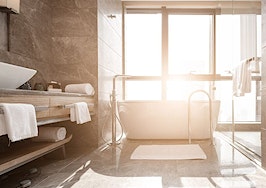A popular, irreverent comedian included in his act a bit about houses, stating that they are places to store all our “stuff.” The bigger the house, the more “stuff” we put in it and the more we acquire, collect and retain.
Storage of all kinds is featured heavily in advertisements for real estate listings. For a spacious two-bedroom apartment that I recently listed, which had six closets, the first inquiry was about additional storage in the building.
Houses feature not only closets, but in many locations, attics, garages, basements and even outbuildings. Anyone who has ever lived in a city apartment will testify to the value of a bike storage room as an apartment building feature.
Struggling with a bike in an elevator or stairway, cleaning the tires before bringing it into an apartment is both inconvenient, unsanitary and awkward. In short: Storage sells homes! Therefore, it’s much better to have too many closets than too few. But where did this obsession with closets come from?
A brief history of closets
In ancient Egypt, belongings were stored in wicker-type baskets. The discovery of pharaoh’s tombs (and the attendant property he was buried with for use in his next life) indicates that royalty and upper-income individuals had abundant property to be stored.
Greeks stored their belongings in wooden chests. Upper-class Greeks used alabaster chests with lids, which were impervious to heat, moisture and vermin.
The average home did not require storage or built-in closets until after the industrial revolution when clothing began to be mass-produced. Until this time, approximately 1760 to 1830, the average individual owned very little clothing — typically a set of clothing for daily wear and an additional set for special occasions.
I have sold apartments in Brooklyn, New York, that were built for seamen and their families in the late 1800s which have one closet for the entire apartment. Many of these built-in closets had drawers built in under the cabinetry for additional storage.
If a real estate listing is in “original condition,” it may lack closets or feature only one very small closet. Apartments that have been modernized or updated can expect to have a closet in each bedroom at best, but they will typically lack a linen closet or entry hall coat closet.
One of the easiest methods to date a house is to review the original floor plan, the number and type of closets.
The French introduced the armoire or wardrobe, a movable closet that offered space for hanging clothing. In the absence of built-in closets, which were introduced in the late 1800s, bedroom suites of furniture featured not only chests of drawers and bureaus, but armoires or wardrobes for hanging garments.
The pantry or cold storage room
Since the middle ages, food and beverages have been stored in a separate space close to the kitchen, which became known as a pantry. The name derives from the old French word for bread “panetiere,” which has roots in the word “pain,” translated from French as “bread.”
The pantry was the room in which silver and table settings were stored. The term butler’s pantry evolved as the butler was responsible for not only polishing the silver but for its safekeeping, so he often slept in the pantry. Another type of pantry would be the cold pantry, an unrefrigerated space for storage of cold food and meats.
First built-in closets in New York City’s Dakota apartment building
To appeal to wealthy residents, apartments in New York’s The Dakota featured built-in closets in their advertising in 1870.
These closets measured 2′-6′ deep and 6′ wide — which was luxurious at the time. Remember, many of the grand houses of Europe and America featured trunk rooms for storage, wine cellars, multiple pantries and storage rooms. Accommodations for live-in staff offered minimal closets, if any, mainly because they wore uniforms, which eliminated the need for closets.
Larger closets come into vogue in the 1950s
Sliding doors, which eliminated the need for hinges and the work of hanging doors separately, came into being in the 1950s. These doors could be purchased as units, installed, with moldings attached.
This type of closet, which essentially doubled the size of the standard 3′ wide closet, was an innovation and step into a luxurious time.
The walk-in closet arrives in 1980
The innovation of the walk-in closet opened up a whole new world of storage in residential construction. Double hanging, or two hanging rods, one above the other, used in the same space, for short items such as shirts and blouses, as well as shelves for shoes and handbags, turned closets into mini boutiques.
By the 2000s, walk-in closets resembled small bedrooms — which they sometimes were — with windows and extensive organization systems. Large closets were equated with status and wealth.
Coordinated by season and often by color and type of clothing, master bedroom suites offered his and her closets, both of which were walk-ins. Walk-in closets in city apartments can serve as home offices, workshops, or with proper ventilation, nurseries.
Closets in the 2000s
Built-in storage walls, also called storage “systems” often take the place of closets in modern construction. Entire walls, from floor to ceiling, can be outfitted with systems of doors and drawers, custom-designed to fit the resident’s needs. Many systems allow for reconfiguration, to adjust to the owner’s changing needs.
Some builders will forgo closets entirely to offer storage walls. Others will offer both. In some high-end new construction, builders assume that the new owner will customize the closets, and while they will include doors to the closet, shelves and a hanging rod are not.
Any type of collection or wardrobe can be accommodated by a custom storage system. Special temperature-controlled storage for furs and exhaust fans to eliminate odors from shoes can be supplemented by adjustable lighting in closets to approximate the atmosphere in which you spend your day or evening.
Every real estate listing will emphasize the most outstanding features to attract buyers, as well as the number and type of closets and storage features.
As an agent, it is wise to know how to intelligently discuss closets and types of storage. In the absence of adequate storage, your selling will be enhanced by the foresight and imagination to suggest where additional or enhanced storage may be added.
Gerard Splendore is a licensed associate real estate broker with Warburg Realty in New York. Connect with him on LinkedIn.













